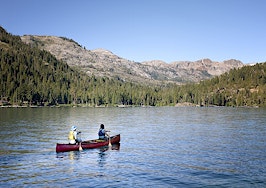California is more than a place, its an idea. And we have Joan Didion to thank for that.
More than 100 years ago, when Southern California wasn’t much more than an winter escape for cold Midwesterners, a group of local boosters began pitching the area as a kind of Shangri-La. The humidity was low. There were beaches (never mind that they were lined with a briar patch of oil derricks). Elegant Mexican fan palms lined the streets. And there was space, so much more so than in the cramped dirty cities of the East.
The pitch worked and as the twentieth century got underway, Southern California boomed. The legend goes that filmmakers fled New York thanks to Thomas Edison’s stranglehold on technology, and soon Hollywood — originally a simple housing development called “Hollywoodland” — became a symbol for new money, new opportunity, and new ambition.
And then something soured.
You can see it in movies like Double Indemnity and Sunset Boulevard and Chinatown and Night Crawler. You can see it in the news, as the dream of hippie utopias congealed into the Manson murders. The myth of New York is about bravado. It’s Frank Sinatra’s New York and Alicia Keyz and Jay Z’s Empire State of Mind.
But the myth of California is different. It’s a story about ease and pleasure on top of something malignant. And it’s this weird dichotomy that makes California — and particularly Los Angeles — at once alluring and dangerous. The world is dotted with places that have good weather or beaches. But there’s nowhere that mixes sunshine and seediness quiet the way Southern California does.
Didion, who died Thursday at the age of 87 from Parkinson’s disease, was one of the primary architects of this myth — and by extension one of the people most responsible for California’s enduring appeal to strivers and dreamers the world over. Without Didion, there might not be a line of buyers lined up for all those California Spanish houses everyone is nuts about in the Hollywood Hills. Los Angeles might as well be Miami or San Diego.

Joan Didion and her husband John Gregory Dunne in Los Angeles in October 1972. Credit: Frank Edwards, Fotos International and Getty Images
Didion was born in 1934 in Sacramento. Her family descended from the ill-fated Donner Party. By the 1950s, she had earned a bachelor’s in English from the University of California, Berkeley. She soon landed a job at Vogue, and by the 1960s was a rising star in the New Journalism movement, which tried to inject elements of novelistic flair and subjectivity into news reporting. Her writing appeared in the most prestigious and widely read publications of the era.
Though she ended up based in New York for her writing gigs, Didion’s fame particularly grew as she chronicled the counterculture movement of 1960s California. In 1967, she wrote an essay titled “Slouching Toward Bethlehem” about her time in San Francisco’s Haight-Ashbury district. Nothing much happens in the essay. There’s no breaking news or overarching story. But it captured a gritty realism that, at the time, electrified readers.
By 1968, the essay became the title piece in a groundbreaking collection that explores the California myth. The collection’s opening essay was dubbed “Some Dreamers of the Golden Dream,” but chronicled the trial of a woman convicted of murdering her husband. Didion sympathizes with the woman, but the line between the California dream and a nightmare is a hazy one.
Buried near the end of Slouching Toward Bethlehem Didion included another essay, “Los Angeles Notebook,” that captures her Golden State thesis. The essay ponders the Santa Anas, hot dry winds that come racing into the Los Angeles basin each year. Didion wrote that in the lead up to the the winds arriving, there was “something uneasy in the Los Angeles air this afternoon, some unnatural stillness, some tension.”
“I have neither heard nor read that a Santa Ana is due, but I know it, and almost everyone I have seen today knows it too,” she continued. “We know it because we feel it. The baby frets. The maid sulks. I rekindle a waning argument with the telephone company, then cut my losses and lie down, given over to whatever it is in the air. To live with the Santa Ana is to accept, consciously or unconsciously, a deeply mechanistic view of human behavior.”
Didion went on to describe the Santa Anas as a “persistent malevolent” wind, linking them to suicide and unhappiness.
“The heat was surreal,” Didion wrote. “The sky had a yellow cast, the kind of light sometimes called ‘earthquake weather.’ My only neighbor would not come out of her house for days, and there were no lights at night, and her husband roamed the place with a machete. One day he would tell me that he had heard a trespasser, the next a rattlesnake.”
It’s strange to think of passages like this, or of essays about murderous housewives, building the myth of California. They run exactly counter to the effort of the region’s early boosters, who billed the state as an easy-going paradise. Why would anyone want to go to a place that is hot and seedy?
But Didion’s writing walked a tightrope. It cast California as a place where sweet ocean breezes swirled together with the malevolent winds from the east. To be in California, or become a Californian, was to strive for utopia while taking your chances with chaos. There’s some danger in the idea of California, and that’s part of the appeal.
Following Slouching Toward Bethlehem, Didion would go on to have a prolific career. She published dozens of works that include fiction, nonfiction and screenplays. A cultural icon, her work is still hotly debated today.
It’s difficult to quantify the ultimate impact of this work. But there’s little doubt that Didion, as an architect of the California myth, influenced the desire for life in the state. And despite high costs and a changing cultural landscape, a brief chat with any real estate agent from the region is enough to learn that there’s still plenty of demand for the myth, freedom and chaos of California.












